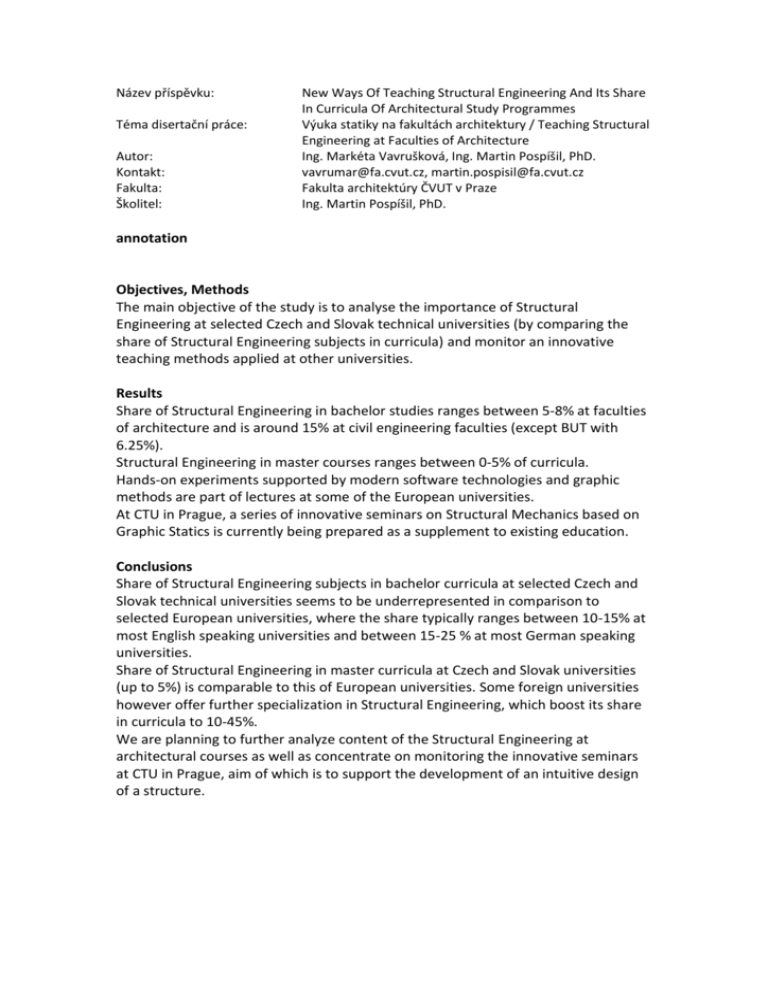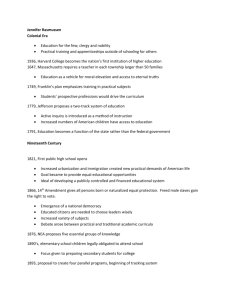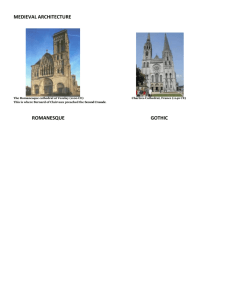Název příspěvku: New Ways Of Teaching Structural Engineering
advertisement

Název příspěvku: Téma disertační práce: Autor: Kontakt: Fakulta: Školitel: New Ways Of Teaching Structural Engineering And Its Share In Curricula Of Architectural Study Programmes Výuka statiky na fakultách architektury / Teaching Structural Engineering at Faculties of Architecture Ing. Markéta Vavrušková, Ing. Martin Pospíšil, PhD. vavrumar@fa.cvut.cz, martin.pospisil@fa.cvut.cz Fakulta architektúry ČVUT v Praze Ing. Martin Pospíšil, PhD. annotation Objectives, Methods The main objective of the study is to analyse the importance of Structural Engineering at selected Czech and Slovak technical universities (by comparing the share of Structural Engineering subjects in curricula) and monitor an innovative teaching methods applied at other universities. Results Share of Structural Engineering in bachelor studies ranges between 5-8% at faculties of architecture and is around 15% at civil engineering faculties (except BUT with 6.25%). Structural Engineering in master courses ranges between 0-5% of curricula. Hands-on experiments supported by modern software technologies and graphic methods are part of lectures at some of the European universities. At CTU in Prague, a series of innovative seminars on Structural Mechanics based on Graphic Statics is currently being prepared as a supplement to existing education. Conclusions Share of Structural Engineering subjects in bachelor curricula at selected Czech and Slovak technical universities seems to be underrepresented in comparison to selected European universities, where the share typically ranges between 10-15% at most English speaking universities and between 15-25 % at most German speaking universities. Share of Structural Engineering in master curricula at Czech and Slovak universities (up to 5%) is comparable to this of European universities. Some foreign universities however offer further specialization in Structural Engineering, which boost its share in curricula to 10-45%. We are planning to further analyze content of the Structural Engineering at architectural courses as well as concentrate on monitoring the innovative seminars at CTU in Prague, aim of which is to support the development of an intuitive design of a structure. INTRODUCTION The subject is being analysed for the use of the Faculty of Architecture in Prague, Czech Republic, which currently supports a research monitoring volume of Structural Engineering at faculties of architecture together with looking into an innovative lecturing techniques successfully applied at them. Over the last twenty years, number of universities and their faculties offering architectural studies has risen significantly, which brought almost tenfold increase of architectural students. At the present time, there are two main trends in architectural education: technical faculties with newly established architectural study programmes (often offering cross-listed courses, e.g. Architecture and Civil Engineering) put the emphasis on technical subjects, whilst traditional schools of architecture have the tendency of simplifying them in order to comply with the lower standard of technical subjects basis of incoming students.6 ECTS STANDARD All of the universities from our sample support ECTS (European Credits Transfer and Accumulation System), which has been used as an objective quantity indicator. It represents a standard for comparing the study attainment and performance of students of higher education across the European Union and other collaborating European countries. One academic year corresponds to 60 ECTS credits that are equivalent to 1500-1800 hours of study in all countries. SELECTION OF UNIVERSITIES We have selected the following leading Czech and Slovak technical universities for our study: Fig. 1 Selected Czech and Slovak technical universities located on the map Legend: 1 BUT 2 CTU 3 STU 4 TUL 5 TUO Brno University of Technology, Czech Republic Czech Technical University in Prague, Czech Republic Slovak University of Technology, Bratislava, Slovakia Technical University of Ostrava, Czech Republic Technical University of Liberec, Czech Republic SELECTION OF COURSES At the present time, universities from our sample offer following architectural courses: 8,9,10,11,12 BACHELOR COURSES UNIVERSITY FACULTY STUDY PROGRAMME STUDY BRANCH LENGTH OF STUDY (YRS) BUT FA FCE CTU FA FCE STU FA FCE TUL FAA TUO FCE Architecture and Urbanism Architecture of Building Structures Architecture and Urbanism Architecture and Building Structures Architecture and Urbanism Building Structures and Urbanism Architecture and Urbanism 4 4 Architecture 3 Architecture and Building Structures 4 4 4 Architecture 4 Architecture 4 and Construction Fig. 2 Overview of bachelor architectural courses at selected Czech and Slovak technical universities MASTER COURSES UNIVERSITY FACULTY STUDY PROGRAMME STUDY BRANCH BUT FA Architecture and Urbanism Architecture, Management in Arch., Space Planning FCE Architecture and Development of Human Settlement Architecture and Urbanism Architecture and Building Structures, Architecture and Urbanism Architecture and CTU FA FCE STU FA LENGTH OF STUDY (YRS) 2 2 Architecture and Urbanism 2 2 2 Urbanism FCE TUL FAA TUO FCE Building Structures and Architecture, Designing Building Structures Architecture and Urbanism 2 Architecture 2 Architecture 2 and Construction Fig. 3 Overview of master architectural courses at selected Czech and Slovak technical universities Legend: FA Faculty of Architecture FCE Faculty of Civil Engineering FAA Faculty of Art and Architecture STRUCTURAL ENGINEERING AS A PROPORTION OF CURRICULA AT SELECTED CZECH AND SLOVAK UNIVERSITIES We have made the following observations for bachelor courses: 1. At faculties of architecture in our sample share of Structural Engineering subjects ranges between 5-8% of curricula (11-18 credits per the whole study). Faculty of Architecture at CTU and Faculty of Art and Architecture at TUL have higher share of Structural Engineering in their curricula compared to the other two faculties from our sample; 8.33% (11 credits) and 7.5% (18 credits) respectively vs. approximately 5%. (see additional note 1. at the bottom of the page) 2. At faculties of civil engineering, share of Structural Engineering subjects is typically around 15% of curricula with approximately 40 credits per the whole course. With its 6.25% of curricula and 15 credits Structural Engineering subjects appear underrepresented at BUT. We have made the following observations for master courses: 1. Share of Structural Engineering subjects is represented less in the master courses vs. the bachelor courses. 2. Structural Engineering accounts for less than 5% in 3 of 8 faculties from our sample. It is not represented in master courses in the remaining ones. Fig. 4 Structural Engineering in curricula at selected Czech and Slovak technical universities Additional notes: 1. Lower percentual share of Structural Engineering subjects in curricula of faculties of architecture at TUL vs. CTU (despite higher volume of credits) is due to the shorter length of study at CTU. 2. Both in its master and bachelor courses, most of the universities from our sample offer further optional courses which can boost the share of Structural Engineering subject by 2-6 credits in total. SHARE OF STRUCTURAL ENGINEERING SUBJECTS IN CURRICULA OF SELECTED CZECH AND SLOVAK VS. SELECTED EUROPEAN UNIVERSITIES Structural Engineering represents between 5-8% of bachelor curricula at faculties of architecture and around 15% of similar curricula at faculties of civil engineering in the Czech Republic and Slovakia. Most European English speaking universities have 10-15% of Structural Engineering in their curricula, however at leading British universities (UCL London, Cambridge) and for combined courses (Architectural Engineering) its share represents around 35% of curricula. In comparison to English speaking European universities German speaking European universities show overall higher volume of Structural Engineering in their courses, which varies between 15-25%.7 Share of Structural engineering in curricula for master courses from our sample of selected Czech and Slovak technical universities is comparable to one of selected German and English speaking universities with values in the range between 0-5%. Some foreign universities however offer further specialization in Structural Engineering, which boost its share in curricula to 10-45%. INNOVATIVE METHODS OF TEACHING STRUCTURAL ENGINEERING Traditional approach to teaching (teacher-centered instruction and behaviourism) was formed as a reflection of scientific thinking. Introduced sophisticated mathematic models might be adequate for civil engineering students, but are considered less appropriate for students of architecture who are used to learn in visual, creative way. It has been observed, that some students apply the method as a routine without considering whether it makes sense, which might get them into difficulties when they need to apply the knowledge in a different context. Nowadays, the student-centered instruction and constructivism model of education is considered as more appropriate, because it helps to develop skills such as critical thinking, ability to solve problems, work in a team and communicate.1 1.Hands-on experiments Experiments with a real small scale structures have brought a visual aspect of learning into the learning process. Highly appraised by professor Künzle 4 from ETH Zurich, according to whom it can help students better understand the fundamental principles of structural behaviour. Used also in Great Britain (London Imperial College) or Spain (College of Architecture in Madrid, University Jaume I de Castellon).3 2.Modern Software Technologies Virtual models can be created simultaneously to hands-on experiments using computer software. Structure is analyzed (deformed shape, maximum displacement, normal forces, bending moment…) and further improved until the optimum design is reached. This interactivity helps students visualize abstract concepts and overall leads to better understanding of structural behaviour. Examples of structural analysis learning programs are: Easy Statics and eQuilibrium (ETH Zurich), Structural Gizmos (Washington), Deflect (Glasgow) or Grips (Stuttgart).1,3,5 3.Graphic Methods The main principle of graphic statics is using force polygons and simple geometric construction techniques, which provide us with visual information about the relation between form and forces in a structural system. Solution is comparably accurate to theoretical methods. Above mentioned eQuilibrium is graphic statics based.6 Graphostatics methods as a tool for lecturing on structures are highly recommended by Karl-Eugen Kurrer (2003), according to whom the clarity of graphical techniques has a high didactic value, since interdependencies, e.g. between forces and structural geometry, can be directly experienced visually.2 INNOVATIVE METHODS OF TEACHING STRUCTURAL ENGINEERING AT CTU A series of innovative seminars on Structural Mechanics based on Graphic Statics is currently being prepared at Faculty of Architecture, CTU, in Prague. Five types of statically determinate plane structures will be discussed in six seminars. In each seminar, an elementary theory describing principles of static behavior of the particular structure will be explained. Then the students will build a physical model of the structure supplemented with measuring the internal forces by loading of the model. Finally, the students will create an appropriate virtual computer-aided model with loading stimulation. To construct the structures, a teaching aid will be prepared containing a board for demonstration and a building set suitable for creating the truss structures (rods, joints, tackles) supplemented by nylon cables, weights and force transducers.6 CONCLUSIONS With its 8.33% share Structural Engineering subjects are underrepresented in bachelor curricula of the Faculty of Architecture at CTU compared to European German and English speaking universities. We are planning to further analyze content of the Structural Engineering at architectural courses to draw further and more detailed conclusions on this subject. Furthermore, we are going to closely monitor above described pilot project at Faculty of Architecture, CTU in Prague, aim of which is to supplement existing education of statics and applied structural mechanics. By designing both real-life models (on which internal forces caused by loading will be measured) and virtual computer-aided models, development of intuitive design of a structure is going to be supported. It is usually an architect, who is designing geometry of a structure and that is why he or she should be familiar with the relationship between the geometry of structure and its load carrying capacity. ACKNOWLEDGEMENT This study has been conducted at the Faculty of Architecture, CTU in Prague, within the framework of the student research project SGS14/211/OHK1/3T/15 supported by CTU in Prague. SOURCES OF RESEARCH 1. Claudia Pedron, An Innovative Tool for Teaching Structural Analysis and Design (dissertation), ETH Zürich, 2006 2. Rolf Gerhardt - Karl-Eugen Kurrer - Gerhard Pichler, The methods of graphical statics and their relation to the structural form, in: Proceedings of the First International Congress on Construction History, Madrid, 20th-24th January 2003 3. Manuel L.Romero - Pedro Museros, Structural analysis education through model experiments and computer simulation, Journal of Professional Issues in Engineering Education and Practice, nr.128, 2002, pg. 170-175 4. Otto Künzle et al., Demonstrationen an Tragwerksmodellen, Institut für Hochbautechnik, HBT, ETH Zürich, 2001 5. BLOCK Research Group, eQuilibrium [online], availble at: http://block.arch.ethz.ch/equilibrium/ , cit. 02.05.2014 6. Martin Pospisil - Marketa Vavruskova, - Eva Vertatova, New Ways of Teaching Statics and Applied Structural Mechanics to Architects, in: Journal from 52nd Conference on Experimental Stress Analysis, Marianske lazne, 2nd5th June 2014 7. Martin Pospisil - Marketa Vavruskova, Share of Structural Engineering in Curricula of CTU vs. selected European Faculties of Architecture, to be published in: Journal from International Education Technology Conference, Chicago, 3rd-5th September 2014 8. Study plans for BUT [online], cit. 01.07. 2014, available at: http://www.fa.vutbr.cz/files/studium/seznam_predmetu_bakal1415.pdf http://www.fa.vutbr.cz/files/studium/seznam_predmetu_magister1415.pdf http://www.fce.vutbr.cz/studium/programy/programy.asp?rosId=84 http://www.fce.vutbr.cz/studium/programy/programy.asp?rosId=85 http://www.fce.vutbr.cz/studium/programy/programy.asp?rosId=86 http://www.fce.vutbr.cz/studium/programy/programy.asp?progid=37 9. Study plans for CTU [online], cit. 30.06. 2014, available at: http://15122.fa.cvut.cz/?page=en,courses http://www.fa.cvut.cz/Cz/Studium http://www.fsv.cvut.cz/bk/bk2014/bc/ba.pdf http://www.fsv.cvut.cz/bk/bk2014/mgr/ma.pdf 10. Study plans for STU [online], cit. 02.07. 2014, available at: http://www.fa.stuba.sk/docs//studium/Studijne_programy_odbory_profily_ 2012_2013.pdf http://www.fa.stuba.sk/docs//stud_odd/Stud_plany_Bc_AU_2014_15.pdf http://www.fa.stuba.sk/docs//stud_odd/Povinne_A_Ing_2014_15.pdf http://www.fa.stuba.sk/docs//stud_odd/Vyber_AU_Ing_2014_15.pdf http://www.fa.stuba.sk/docs//stud_odd/Povinne_U_Ing_2014_15.pdf http://www.svf.stuba.sk/docs/B-PSA_2013-14.pdf http://www.svf.stuba.sk/docs/I-PSA_2013-14.pdf http://www.svf.stuba.sk/docs/I-AKP_2013-14.pdf 11. Study plans for TUL [online], cit. 04.07. 2014, available at: http://stag-new.tul.cz/wps/portal/ 12. Study plans for TUO [online], cit. 03.07. 2014, available at: http://edison.sso.vsb.cz/cz.vsb.edison.edu.study.prepare.web/StudyPlanPub licView.faces?facultyId=2









